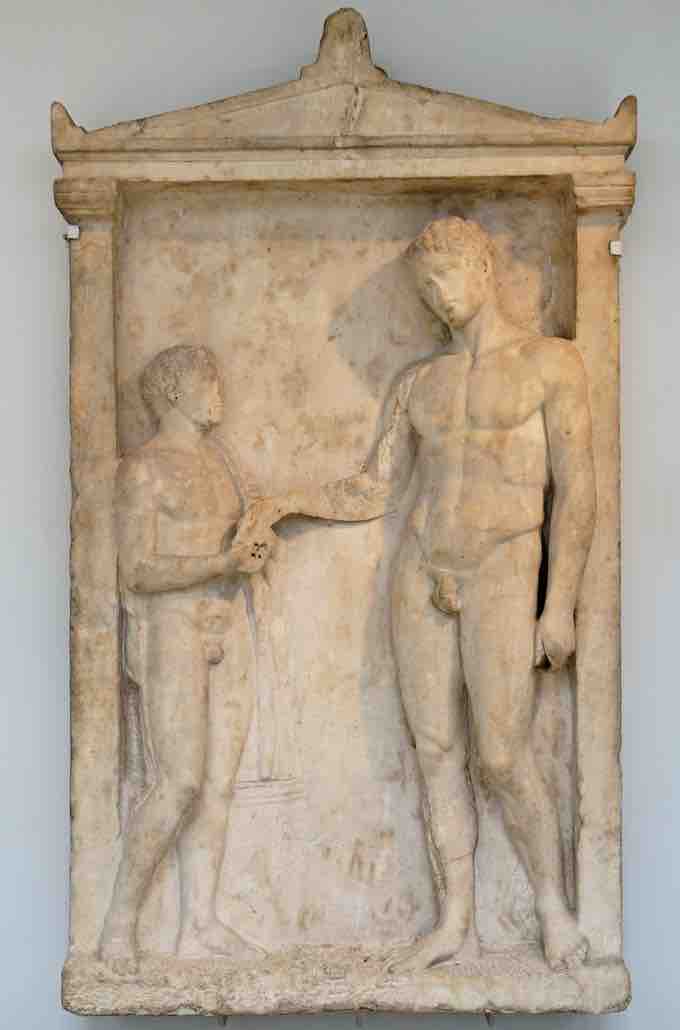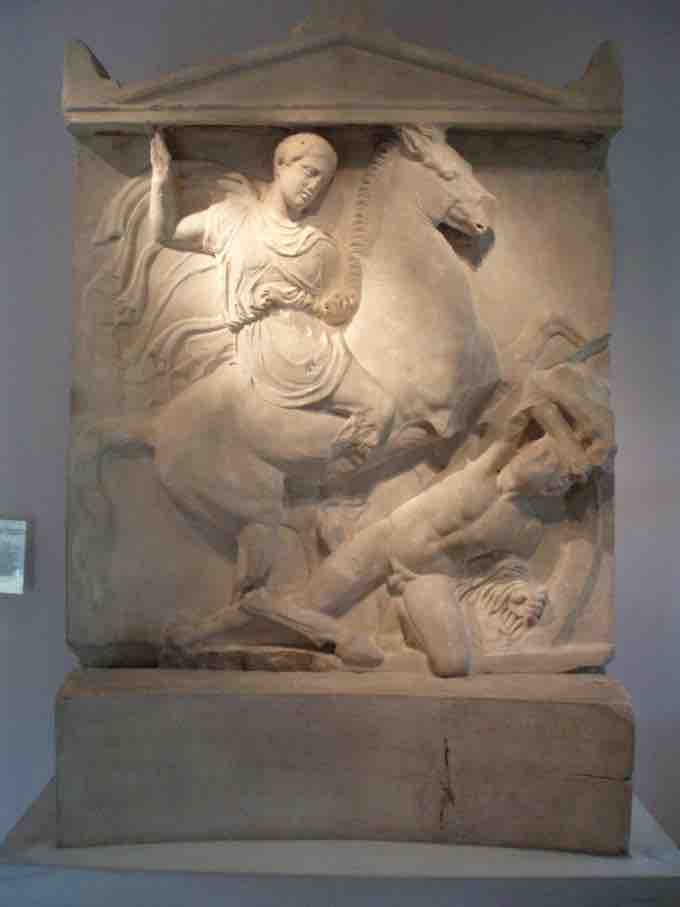A stele (plural stelae) is a large slab of stone or wood erected for commemorative and funerary purposes. The stelae of ancient Greece replaced the funerary markers of the geometric kraters and amphorae and Archaic kouroi and korai in the Classical period. The stelae were wide and tall and were Classical-style portraits. While the figures were still idealized, they were meant to represent specific individuals. Stelae were inscribed with the name of the dead and often the names of the relatives. Most stelae are rectangular and often topped with a pediment. Columns often but not always appear on each side, seemingly to support the pediment. Stelae in this faux architectural style assume the form of a funerary temple called a naiskos. An inscription would be located on the pediment or else below the image, in which case the pediment was painted, plain, or decorated simply with geometric designs.
The figures depicted on Classical-era stelae are in the same style and manner seen in Classical sculpture and on sculptural decoration of architecture, such as a temple's pediments and frieze. Stelae as grave markers became popular around 430 BCE, coinciding with the beginning of the Peloponnesian War. Each stele is unique for its attempts to individualize and characterize the attributes and personality of the dead.
Grave Stele of Hegeso
The Grave Stele of Hegeso from the Kerameikos Cemetery outside of Athens depicts a seated woman. The stele dates to 400 BCE, and the woman fits the stylistic representation of women at this time. Hegeso sits on a chair with her feet resting on a footstool. She is elegantly dressed in long flowing drapery. A female attendant in simple dress stands before her holding a small box, from which Hegeso chooses jewelry. The jewelry is now absent because it was only a painted detail, as opposed to carved in relief. Both women wear transparent clothing that clings to their body to relieve their feminine form, although the clothing is more revealing on Hegeso than her servant. This style, known as "wet drapery," also appears on the Temple of Athena Nike in Athens. Both figures are expressionless and emotionless.

Grave Stele of Hegeso.
Marble. c. 400 BCE. Dipylon Cemetery, Athens, Greece
Grave Stele of an Athlete
The Grave Stele of an Athlete (early fourth century BCE) from the island of Delos depicts a male athlete receiving lekythos of oil from a male youth. The athlete's body is reminiscent of Polykleitos's Doryphoros. It is athletic, and the muscles are defined through modeling instead of lines. He stands in a contrapposto pose with a cocked head, reaching for the flask held by the young attendant. The youth's age is defined not by his well-built body (which is very similar to that of the athlete) but by his diminutive size.

Grave Stele of an Athlete
Marble. c. 375 BCE. Delos, Greece.
Grave Stele of Dexileos
The Grave Stele of Dexileos (390 BCE) in the Kerameikos Cemetery of Athens is another demonstration of how stele reliefs reflect the sculpture style and motifs of the period. This stele recalls the carved relief of Athenian horsemen from the Ionic frieze of the Parthenon. Dexileos rides astride a rearing horse, charging down an enemy. The inscription refers to his early death in battle against the Corinthians. He probably originally held a metal spear in his raised hand. The two figures, Dexileos and the Corinthian, are dressed differently. The Corinthian's nudity signifies his difference from the civilized Athenian who is properly clothed. Dexileos's flying cape and rearing horse add drama to scene, which despite its content, is oddly expressionless due to emotionless faces of the characters.

Grave Stele of Dexileos.
Marble. c. 390 BCE. Dipylon Cemetery, Athens, Greece.
Grave Stele of a Little Girl
While the above stelae commemorate adults, grave stelae also commemorated those who died as children. The Grave Stele of a Little Girl (450-440 BCE), which lacks a pediment and allows the deceased to assume most of the space, depicts a young child holding two doves, presumably her pets. One bird perches in her hands, while the other seems to cuddle next to her and affectionately peck at her mouth. She bows her head toward both doves, wearing a solemn facial expression, as if bidding the animals farewell. Such images of children and companion animals are common subject matter on grave stelae of the Classical era. Doves' ability to fly connected them to death and the afterlife. Some experts theorize that doves were believed to be able to communicate with those in the afterlife. Like the women on the Grave Stele of Hegeso, the child's clothing assumes the "wet drapery" style to accentuate the contours of her body while allowing her to maintain "feminine" modesty.
Grave Stele of a Little Girl
Marble. Island of Paros. c. 450-440 BCE.